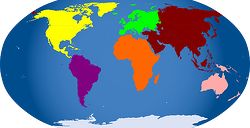Overcoming Geographic Challenges (Part 2 of a 4 Part Series)
Updated June 14, 2016
In my last post, I committed to an ongoing discussion about issues you should consider before replacing or upgrading an existing hydropower turbine. These are challenging projects which will tax even the most savvy operator. I also discussed ways to mitigate risks through effective contracting and project management.
The topics in this series include:
-
Risk Management - COMPLETE
-
Geographic Challenges
In this second of my four part series I’ll discuss geographic challenges.
As a hydropower operator, you are faced with a number of geographic challenges when replacing or upgrading existing hydropower turbines. Not only are you sourcing parts from all over the world but your facilities are located in remote locations, making accessibility for staff, contractors, and deliveries problematic.
Where in the world will my next part come from?
On the last turbine upgrade I worked on, materials and parts were fabricated or refurbished in Korea, Canada, Austria and Slovenia. With these diverse countries and cultures you are not only dealing with language barriers, but also different philosophies in processes and expectations. Keep in mind, the time zones may add differences between 3-12 hours.
Time zone challenges require patience and planning. It is important to work with suppliers early in the process to identify appropriate communication strategies. Don’t underestimate the effectiveness of simple email. Questions can be sent out at the end of day, and typically a response comes back by the time the project starts back up in the morning. Conference calls can be difficult to impossible. If needed, conference call times should be rotated to “spread the pain” of off-hour communications among the entire team.
Another struggle is getting equipment and supplies on site in a timely, orderly fashion. Many dams are located in remote regions of the country and typically don’t have the infrastructure to store large replacement parts for an extended period of time. In my last project, onsite storage became a significant issue. I worked with the client and contractor to develop a storage plan in advance of delivery. This planning increased efficiency and improved site conditions for the owner, who was operating the facility around the construction activities. In this situation, the agency’s existing facilities were used for offsite storage.
How will I keep competent project staff?
When remote, the staffing of hydro projects can be a big challenge. The cost of construction management and inspection staff turnover is significant and often underestimated. You just can’t afford to allow details to fall through the cracks or lose continuity in contractor and/or supplier management.
Construction management staff should be hired with a track record of completing long duration construction projects in remote locations. These are professionals who are used to the realities of working in such conditions. Additionally, I’d suggest a staffing plan that allows for contingency planning and backup staffing. Admittedly, this might be difficult and expensive, but again continuity throughout the project cannot be undervalued.
Although the focus of this post is not about the benefits of hiring a consultant to service these needs, a competent consultant construction management and inspection firm can solve your remote staffing challenges. Our construction managers and inspectors almost solely service remote project needs. Our deep bench of technical people allows flexibility to cover staffing for unexpected staff departures and / or peaks in construction activities. Most importantly, our team focuses on remote energy projects. This means our staff are conditioned for the realities of such assignments.
Regardless of how you tackle these issues, proper planning around these remote projects is essential. I’d love to hear about your experience managing similar projects. Please feel free to contact me to discuss strategies that would make your project more successful.
Email me or contact me at pcarroll@mackaysposito.com
To read part 3 in this series, click here.



Leave us a comment below